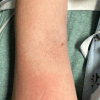Rash and Fever in a Returned Traveler
- PMID: 38869348
- PMCID: PMC11166069
- DOI: 10.5811/cpcem.1911
Rash and Fever in a Returned Traveler
Abstract
Case presentation: A 21-year-old, otherwise healthy female presented to the emergency department with fever among other nonspecific symptoms after recently returning from Ghana. On physical exam, she had a characteristic upper extremity rash, and a tourniquet test revealed numerous petechiae. The diagnosis of dengue was suspected and subsequently confirmed.
Discussion: Dengue is one of many viral illnesses that should be considered in returning travelers presenting with fever and other nonspecific symptoms. Emergency physicians must keep a broad differential when evaluating fever in returned travelers and prioritize history and physical exam findings to help narrow the diagnosis and provide appropriate management and supportive care while awaiting further confirmatory testing.
Conflict of interest statement
Figures


References
-
- World Health Organization . Dengue and severe dengue. 2023. Available at: https://www.who.int/en/news-room/fact-sheets/detail/dengue-and-severe-de.... Accessed September 29, 2023.
-
- Centers for Disease Control and Prevention . Dengue: historic data (2010–2022). 2022. Available at: https://www.cdc.gov/dengue/statistics-maps/2020.html. Accessed August 1, 2023.
-
- Thwaites GE, Day N. Approach to fever in the returning traveler. N Engl J Med. 2017;376(6):548–60. - PubMed
